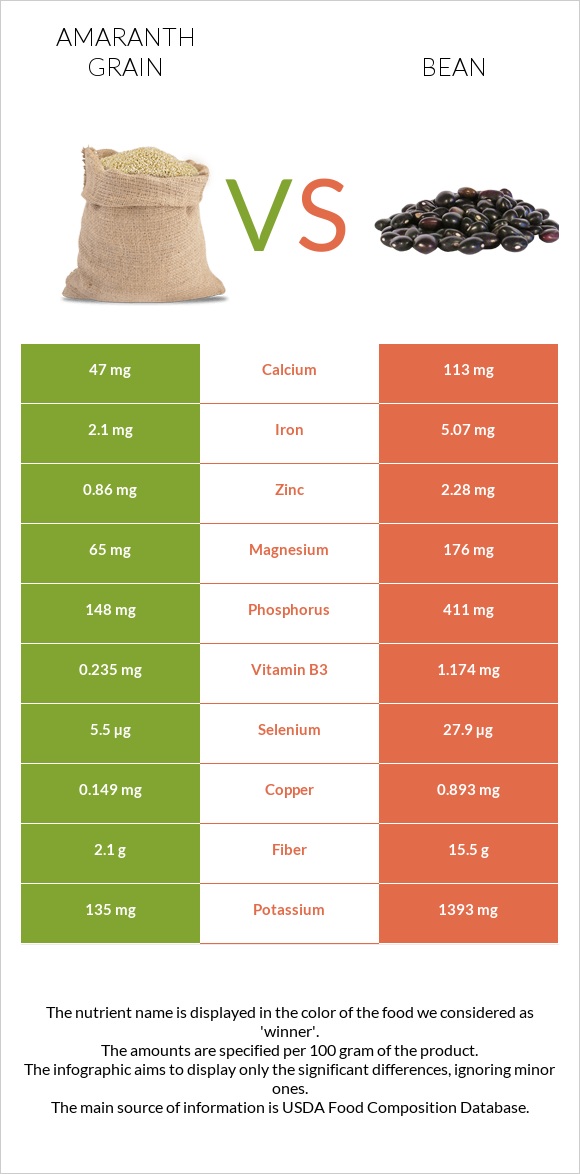Amaranth vs. Beans — In-Depth Nutrition Comparison
Compare
Differences between amaranth and beans
- Amaranth has more iron, magnesium, and phosphorus, while beans have more fiber, vitamin B1, and copper.
- Amaranth's daily need coverage for iron is 23% higher.
- Beans contain 2 times less magnesium than amaranth. Amaranth contains 65mg of magnesium, while beans contain 32mg.
- Beans have a lower glycemic index. The glycemic index of beans is 33, while the glycemic index of amaranth is 97.
The food types used in this comparison are Amaranth grain, cooked and Beans, baked, canned, no salt added.
Infographic

Infographic link
Mineral Comparison
Mineral comparison score is based on the number of minerals by which one or the other food is richer. The "coverage" charts below show how much of the daily needs can be covered by 300 grams of the food.
| Contains more MagnesiumMagnesium | +103.1% |
| Contains more IronIron | +624.1% |
| Contains more PhosphorusPhosphorus | +42.3% |
| Contains more ManganeseManganese | +∞% |
| Contains more SeleniumSelenium | +22.2% |
| Contains more PotassiumPotassium | +119.3% |
| Contains more CopperCopper | +38.3% |
| Contains more ZincZinc | +62.8% |
| Contains less SodiumSodium | -83.3% |
Vitamin Comparison
Vitamin comparison score is based on the number of vitamins by which one or the other food is richer. The "coverage" charts below show how much of the daily needs can be covered by 300 grams of the food.
| Contains more Vitamin EVitamin E | +26.7% |
| Contains more Vitamin B1Vitamin B1 | +900% |
| Contains more Vitamin B2Vitamin B2 | +172.7% |
| Contains more Vitamin B3Vitamin B3 | +83% |
| Contains more Vitamin B6Vitamin B6 | +15% |
All nutrients comparison - raw data values
| Nutrient |  |
 |
DV% diff. |
| Manganese | 0.854mg | 37% | |
| Iron | 2.1mg | 0.29mg | 23% |
| Fiber | 2.1g | 5.5g | 14% |
| Vitamin B1 | 0.015mg | 0.15mg | 11% |
| Magnesium | 65mg | 32mg | 8% |
| Starch | 16.23g | 7% | |
| Copper | 0.149mg | 0.206mg | 6% |
| Phosphorus | 148mg | 104mg | 6% |
| Choline | 30.8mg | 6% | |
| Potassium | 135mg | 296mg | 5% |
| Zinc | 0.86mg | 1.4mg | 5% |
| Vitamin C | 3.1mg | 3% | |
| Vitamin B2 | 0.022mg | 0.06mg | 3% |
| Protein | 3.8g | 4.8g | 2% |
| Fats | 1.58g | 0.4g | 2% |
| Selenium | 5.5µg | 4.5µg | 2% |
| Carbs | 18.69g | 20.49g | 1% |
| Vitamin A | 5µg | 1% | |
| Vitamin B3 | 0.235mg | 0.43mg | 1% |
| Vitamin B6 | 0.113mg | 0.13mg | 1% |
| Vitamin K | 0.8µg | 1% | |
| Folate | 22µg | 24µg | 1% |
| Polyunsaturated fat | 0.172g | 1% | |
| Calories | 102kcal | 105kcal | 0% |
| Protein per 100 calories | 3.7254901960784315g | 4.571428571428571g | N/A |
| Calories per 10 g protein | 268.42105263157896kcal | 218.75kcal | N/A |
| Net carbs | 16.59g | 14.99g | N/A |
| Calcium | 47mg | 50mg | 0% |
| Sugar | 7.78g | N/A | |
| Sodium | 6mg | 1mg | 0% |
| Vitamin E | 0.19mg | 0.15mg | 0% |
| Saturated fat | 0.103g | 0% | |
| Monounsaturated fat | 0.035g | 0% |
Macronutrient Comparison
Macronutrient breakdown side-by-side comparison
| Contains more FatsFats | +295% |
| Contains more ProteinProtein | +26.3% |
| Contains more OtherOther | +122.1% |
~equal in
Carbs
~20.49g
~equal in
Water
~72.6g




